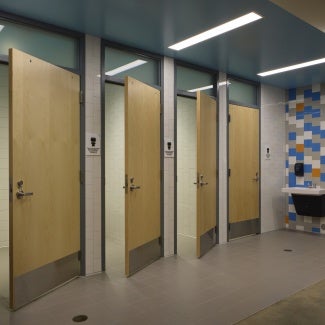ROI: Healthier, more productive occupants
Our indoor environments have a direct impact on our health and wellness. High-performance design elements, such as air quality, thermal comfort, and daylighting, can significantly improve occupant health.

Health benefits to design
At the heart of our built environment—whether homes, offices, schools, or other building types—are the occupants. According to the U.S. Environmental Protection Agency (EPA), Americans spend 87% of their time inside buildings, making the built environment they inhabit critical.
Businesses, individuals, and society benefit from better working environments. Key health benefits include improved air quality, thermal comfort, and access to daylight. A study found that high-performance design elements that address these key benefits produced a total net value of $55.47/sf for increased productivity and $9.03/sf for improved health and wellness, through reduced absenteeism and missed work time, over 10 years.*1
See AIA's Framework for Design Excellence: Design for Well-being for more context.
References:
Literature review completed by University of Washington’s Integrated Design Lab for AIA in 2020.
Good IAQ ensures that building occupants are healthy and productive, leading to benefits for individuals, business owners, and communities. Building parameters that affect IAQ include indoor and outdoor sources of pollution, ventilation rates, airflow patterns and pressure, and air filtration.*1
Key indoor air quality talking points:
- Bringing fresh air into a space dilutes indoor pollutants, prevents recirculation of contaminated air, and ensures required outdoor ventilation rates are met.*2
- Building occupants generate pollutants and odors through their indoor activities, so it is important to regulate ventilation rates based on occupant density to ensure proper dilution of indoor pollutants.*3
Improved IAQ improves occupant health:
- Indoor pollutants can cause morbidity in building occupants, but diluting these pollutants through increased ventilation can reduce their effects on occupants’ health.*4, 5
- A LEED Gold-certified office refurbishment that enhanced indoor ventilation for 150 employees saw an annual savings of $85,000 per year due to a 44% reduction in absenteeism because of better worker health.*6
Improved IAQ improves productivity:
- Reducing indoor air pollutants through increased ventilation has been shown to increase productivity.*5, 7
- A study found that changes in CO2 concentrations from 550 to 945 ppm resulted in a 15% reduction in cognitive test scores. Changes in concentrations from 550 to 1400 ppm resulted in a 50% decrease in cognitive scores. Overall, the typical participant’s cognitive score across all nine cognitive function domains decreased by 21% with a 400 ppm increase in CO2 concentrations.*5
References:
1. ANSI/ASHRAE Standard 62.1-2019 Ventilation for Acceptable Indoor Air Quality
2. Building-Related Illness. Gerardi, D.
5. Associations of Cognitive Function Scores with Carbon Dioxide, Ventilation, and Volatile Organic Compound Exposures in Office Workers: A Controlled Exposure Study of Green and Conventional Office Environments. Allen, J.G., MacNaughton, P., Satish, U., Santanam, S., Vallarino, J., Spengler, J.D.
6. Doing Right by Planet and People: The Business Case for Health and Wellbeing in Green Building. World Green Building Council.
7. Room Temperature and Productivity in Office Work. Seppanen, O. Fisk, W.J. Lei, Q.H.
Thermal comfort is the subjective assessment of one’s thermal satisfaction with the environment and is affected by environmental and personal factors.*1 A review of thermal comfort research found that in seven of nine studies, users rated thermal comfort as the top factor that affects their satisfaction with a building.*2
Key thermal comfort talking points:
- Maintaining thermal comfort has also been found to reduce sick building syndrome (SBS) symptoms in building users.*3, 4
- One study predicted that absenteeism due to SBS symptoms could be up to 34% lower if employees could control their immediate microclimate conditions.*5
- The thermal environment of a space can impact occupants’ mental fatigue.*6, 7
- Many studies have found that temperature influences work performance.*8, 9, 10
- The optimal temperature range for cognitive function was found to be between 71.6–78.8 degrees Fahrenheit.*8
References:
1. Heating, Cooling, Lighting: Sustainable Design Methods for Architects. Lechner, N.
2. A Review of Human Thermal Comfort in the Built Environment. Rupp, R.F., Vasquez, N.G, Lamberts, R.
5. Green Buildings, Organizational Success, and Occupant Productivity. Heerwagen, J.H.
8. Room Temperature and Productivity in Office Work. Seppanen, O., Fisk, W.J., Lei, Q.H.
Daylighting in design refers to allowing natural light into a space through a window or other means. This natural light helps maintain a connection between people and the natural cycle of the sun—known as the circadian rhythm. The biological processes that regulate our sleep-wake cycle make up our circadian system. Primarily through the use of the neurohormone melatonin, our circadian system regulates our patterns of alertness and sleepiness.*1 Daylighting has been shown to benefit occupants in a number of ways, most notably in improved health and productivity.
Key daylighting talking points:
- Regulation of the circadian system is one of the largest ways light impacts physiological health.*2 Studies point to a connection between circadian disruption and increased cancer risk.*3, 4
- Increased performance and productivity due to improved lighting conditions have been observed in various companies, including Lockheed Martin, Verifone, and the Reno Post Office.*5 By moving to an open office with integrated daylight, Lockheed Martin increased contract productivity by 15%, which company leaders believe helped them win a $1.5 billion defense contract.*5
- Saint-Gobain call center staff at the company’s new North American headquarters attributed a 97% increase in sales-generated leads to increased daylighting and views.*6
- Numerous studies have shown that daylit stores have higher sales numbers than non-daylit stores.*5, 7
- Daylight “has aesthetic benefits that encourage customers to enter the store.” The Heschong Mahone Group found that adding skylights increased store sales by 31%-41%.*5
- Multiple hospital studies have found that patients recover faster and have better outcomes in daylit rooms.*3, 5, 8
References:
1. The Benefits of Natural Light. Van Den Wymelenberg, K.
3. Impact of Light on Outcomes in Healthcare Settings. Joseph, A.
4. Endocrine Effects of Circadian Disruption. Bedrosian, T.A., Fonken, L.K., Nelson, R.J.
6. Doing Right by Planet and People: The Business Case for Health and Wellbeing in Green Building. World Green Building Council.
7. The Benefits of Daylight through Windows. Boyce, P., Hunter, C., Howlett, O.
How to use these talking points
These talking points are intended for use in your conversations with clients, potential clients, civic leaders, vendors, contractors, and other architects. This helps demonstrate that architects are trusted partners in strengthening society, designing solutions, and transforming communities.
This is one chapter in AIA’s series ROI of High-Performance Design. Access the full resource below.
Explore the next chapter in ROI of High-Performance Design.



